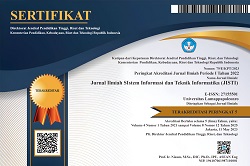YOLO algorithm performance analysis in shrimp seed counting
Abstract
The two main processes in shrimp cultivation are filling and enlargement. The counting of shrimp seeds is part of the filling activity. However, the counting of shrimp after larvae is still done manually, which means taking the shrimp and counting them manually, which is time-consuming and often results in human error. This research proposes a You Only Look Once (YOLO) method to automatically calculate the number of shrimp larvae. The YOLO method is a deep learning model that can detect an object with high speed and accuracy, even under less ideal lighting conditions. In this study, images of objects were taken using a camera placed on top of a white container containing 2 cm of water and photographed with a backlight system to avoid the reflection of light from inside the water. Testing is done by comparing system calculations and manual calculations. The results showed that the system not only detected larvae but also counted the number of shrimp larvae as well as the mAP validation value on the final model built with YOLO, which was 96.83% It also produced an average accuracy with 30 training data of 76.48%.
Downloads
References
Awalludin, E. A., Mat Yaziz, M. Y., Abdul Rahman, N. R., Yussof, W. N. J. H. W., Hitam, M. S., & T Arsad, T. N. (2019). Combination of Canny Edge Detection and Blob Processing Techniques for Shrimp Larvae Counting. Proceedings of the 2019 IEEE International Conference on Signal and Image Processing Applications, ICSIPA 2019, 2011, 308–313. https://doi.org/10.1109/ICSIPA45851.2019.8977746
Awalludin, E. A., Wan Muhammad, W. N. A., Arsad, T. N. T., & Wan Yussof, W. N. J. H. (2020). Fish Larvae Counting System Using Image Processing Techniques. Journal of Physics: Conference Series, 1529(5). https://doi.org/10.1088/1742-6596/1529/5/052040
Chauhan, M. S., Singh, A., Khemka, M., Prateek, A., & Sen, R. (2019). Embedded CNN based vehicle classification and counting in non-laned road traffic. ACM International Conference Proceeding Series, September. https://doi.org/10.1145/3287098.3287118
Nasution, M. M. A. (2023). Pengenalan Jenis Ikan Cupang Menggunakan Metode YOLO. https://doi.org/https://doi.org/10.30811/jaise.v3i2.4588
Nguyen, K. T., Nguyen, C. N., Wang, C. Y., & Wang, J. C. (2020). Two-phase instance segmentation for whiteleg shrimp larvae counting. Digest of Technical Papers - IEEE International Conference on Consumer Electronics, 2020-Janua, 1–3. https://doi.org/10.1109/ICCE46568.2020.9043075
Nurlaela, N., Niswar, M., Nurtanio, I., Fujaya, Y., Kashihara, S., & Fall, D. (2019). Detection of Megalopa Phase Crab Larvae Using Digital Image Processing. 2019 2nd International Seminar on Research of Information Technology and Intelligent Systems, ISRITI 2019, 269–272. https://doi.org/10.1109/ISRITI48646.2019.9034609
Redmon, J., Divvala, S., Girshick, R., & Farhadi, A. (2016). You only look once: Unified, real-time object detection. Proceedings of the IEEE Computer Society Conference on Computer Vision and Pattern Recognition, 2016-Decem, 779–788. https://doi.org/10.1109/CVPR.2016.91
JISTI
















